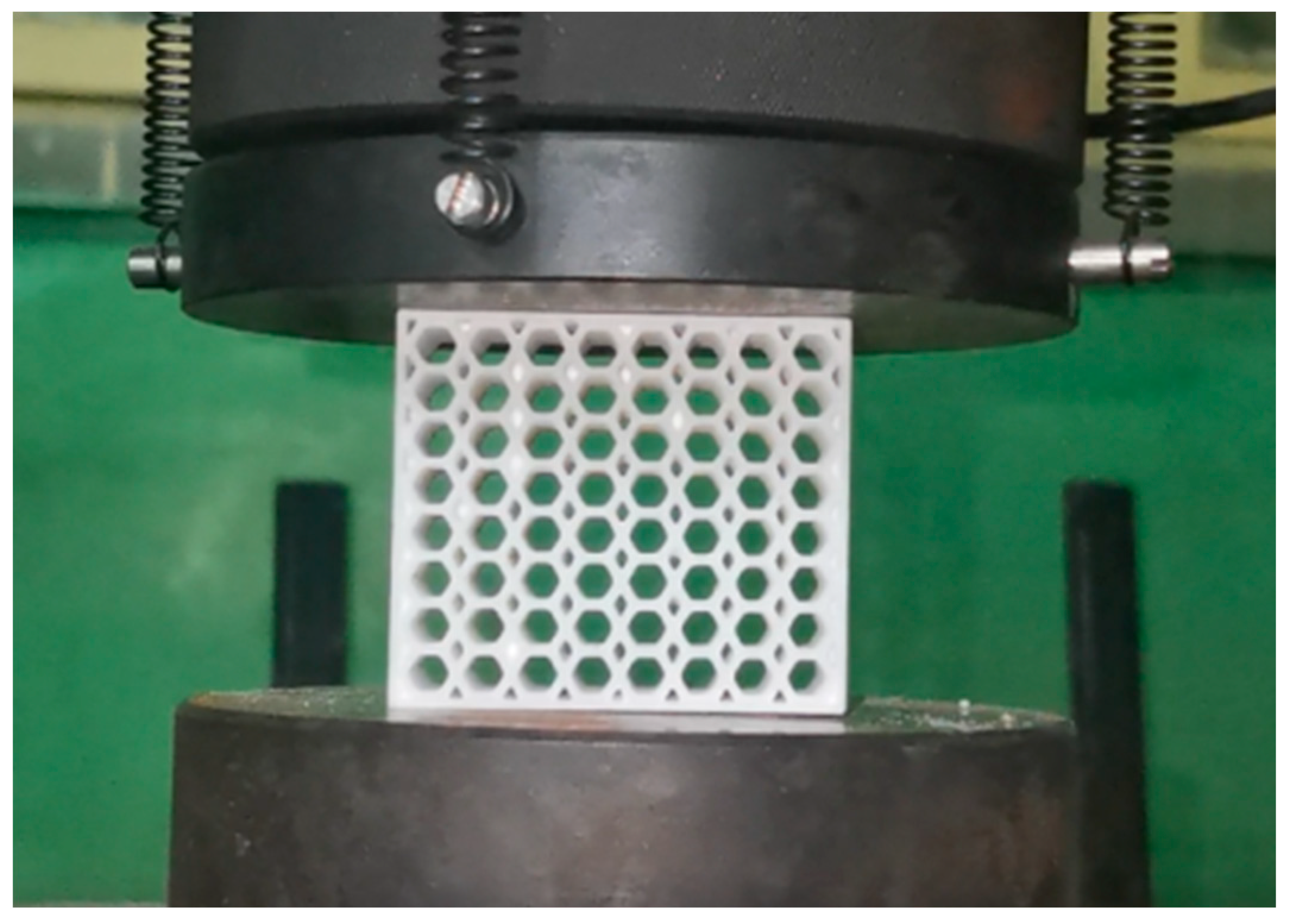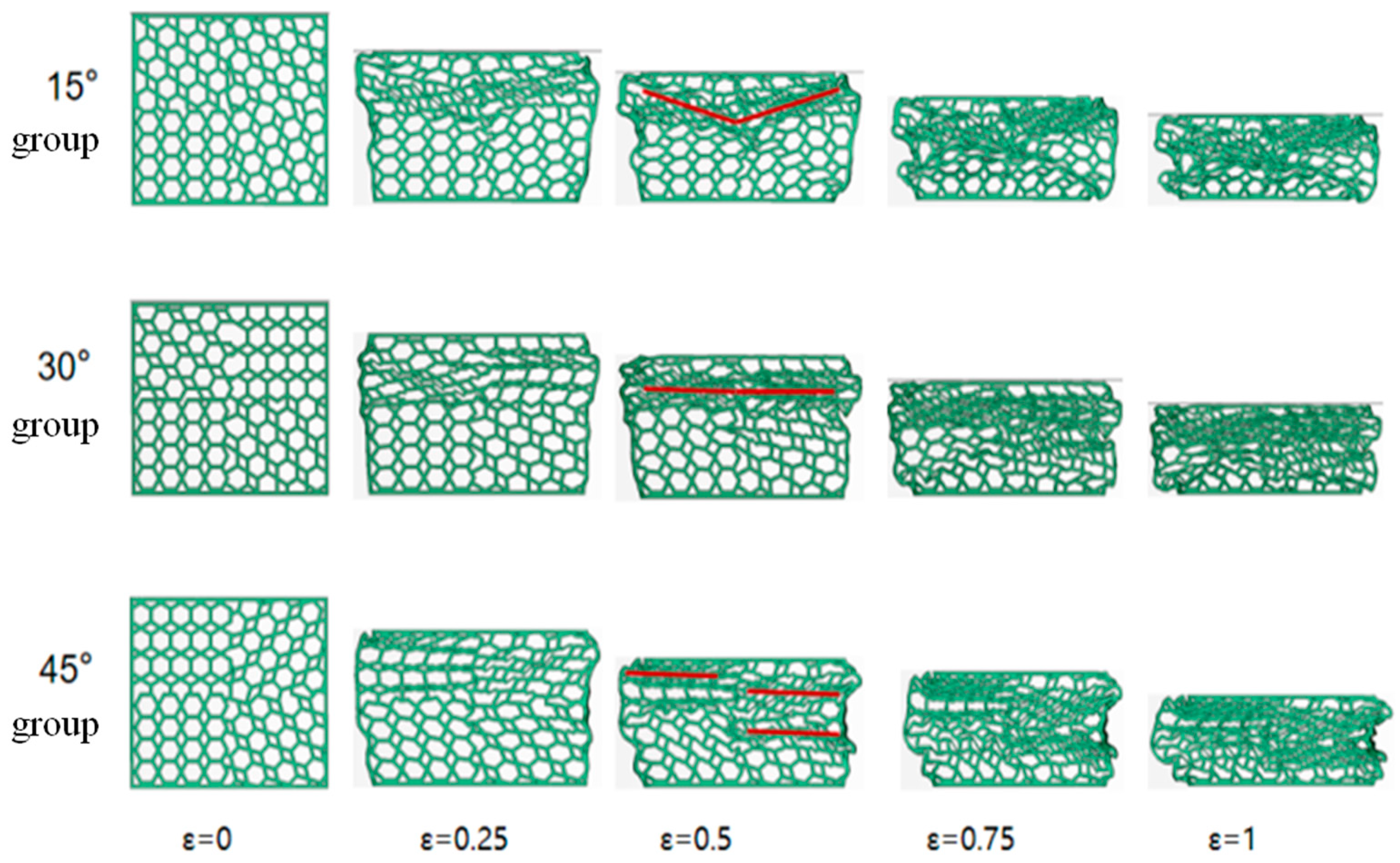Research on In-Plane Deformation Performance of Rotating Honeycomb Structures
Abstract
:1. Introduction
2. Materials and Methods
2.1. Model Design
2.2. Finite Element Simulation Modeling Methods
2.3. Experimental Setup
3. Results and Discussion
3.1. Indicators of Energy Absorption Characteristics
- (1)
- Total Absorption Energy (EA)
- (2)
- Specific energy absorption (SEA)
- (3)
- Mean crushing force (MCF)
- (4)
- Initial peak force (IPCF)
- (5)
- Crushing Force Efficiency (CFE)
- (6)
- Energy Absorption Efficiency (EAE)
3.2. Experimental Results and Model Validation
3.3. Quasi-Static Crushing Response of an Integral Rotating Honeycomb
3.4. Simulation Results of the Combined Design Rotating Honeycomb
4. Conclusions
- (1)
- Deformation patterns: 0° honeycomb has a typical “X” shaped deformation zone, 15°, 30° and 45° are more obvious zigzag deformation zones, all are more uniform in-plane compression deformation patterns; combined rotating honeycomb has obvious layered deformation characteristics, the upper layer deforms first, the lower layer deforms later, and the local deformation zone is obvious.
- (2)
- In terms of platform stress: both the 15° honeycomb and the 0° honeycomb outperform the 30° honeycomb and the 45° honeycomb, and the 15° honeycomb is higher than the 0° honeycomb in terms of average crush force and crush force efficiency, but in the combined rotary honeycomb, the 15° combination is smaller than the 30° and 45° combinations in terms of overall stress-strain curve and average crush force. Compared with the integral honeycomb, the combined honeycomb has higher initial peak force and platform stress, which plays an important role in the energy absorption of the structure.
- (3)
- Energy absorption: The energy absorption capacity of 0 and 15 is significantly higher than that of 30 and 45. The total energy absorption of the 15, 30 and 45 honeycomb was 194 KJ, 213 KJ and 187 KJ, which are 35%, 73% and 71% higher than the overall honeycomb, respectively, 15, 7.76 kN, 8.52 kN and 7.36 kN, respectively, and the 30 honeycomb was better in the combined cells.
Author Contributions
Funding
Institutional Review Board Statement
Informed Consent Statement
Data Availability Statement
Conflicts of Interest
References
- Nian, Y.; Wan, S.; Wang, X.; Zhou, P.; Avcar, M.; Li, M. Study on crashworthiness of nature-inspired functionally graded lattice metamaterials for bridge pier protection against ship collision. Eng. Struct. 2023, 277, 115404. [Google Scholar] [CrossRef]
- Yang, X.; Ma, J.; Wen, D.; Yang, J. Crashworthy design and energy absorption mechanisms for helicopter structures: A systematic literature review. Prog. Aerosp. Sci. 2020, 114, 100618. [Google Scholar] [CrossRef]
- Wang, C.; Li, Y.; Zhao, W.; Zou, S.; Zhou, G.; Wang, Y. Structure design and multi-objective optimization of a novel crash box based on biomimetic structure. Int. J. Mech. Sci. 2018, 138–139, 489–501. [Google Scholar] [CrossRef]
- Boursier Niutta, C.; Ciardiello, R.; Tridello, A. Experimental and Numerical Investigation of a Lattice Structure for Energy Absorption: Application to the Design of an Automotive Crash Absorber. Polymers 2022, 14, 1116. [Google Scholar] [CrossRef]
- Li, Q.Q.; Li, E.; Chen, T.; Wu, L.; Wang, G.Q.; He, Z.C. Improve the frontal crashworthiness of vehicle through the design of front rail. Thin-Walled Struct. 2021, 162, 107588. [Google Scholar] [CrossRef]
- Hou, X.; Yin, G. Dynamic crushing performance analysis for auxetic honeycomb structure. J. Mech. Strength 2016, 38, 905–910. [Google Scholar]
- Shen, Z.F.; Zhang, X.C.; Bai, J.P.; Wu, H.X. Dynamic response characteristic of re-entrant circular honeycombs with negative poisson ‘s ratio. J. Vib. Shock. 2020, 39, 89–95+117. [Google Scholar]
- Khan, S.Z.; Mustahsan, F.; Mahmoud, E.R.; Masood, S.H. A novel modified re-entrant honeycomb structure to enhance the auxetic behavior. Analytical and numerical study by FEA. Mater. Today Proc. 2020, 39, 1041–1045. [Google Scholar] [CrossRef]
- Du, Y.; Sun, P.; Tian, Q.; Fu, J.; Zhou, X.; Ye, X. Design of high-bearing performance honeycomb-like sandwich structure based on topology optimization. Mach. Des. Res. 2021, 37, 31–35. [Google Scholar]
- Liang, H.; Wang, Q.; Pu, Y.; Zhao, Y.; Ma, F. In-plane compressive behavior of a novel self-similar hierarchical honeycomb with design-oriented crashworthiness. Int. J. Mech. Sci. 2021, 209, 106723. [Google Scholar] [CrossRef]
- Xu, F.; Yu, K.; Hua, L. In-plane dynamic response and multi-objective optimization of negative Poisson’s ratio (NPR) honeycomb structures with sinusoidal curve. Compos. Struct. 2021, 269, 114018. [Google Scholar] [CrossRef]
- Wu, W.; Hu, W.; Qian, G.; Liao, H.; Xu, X.; Berto, F. Mechanical design and multifunctional applications of chiral mechanical metamaterials: A review. Mater. Des. 2019, 180, 107950. [Google Scholar] [CrossRef]
- Zhang, E.T.; Liu, H.; Ng, B.F. Novel arc-shaped ligaments to enhance the energy absorption capabilities of re-entrant anti-trichiral structures. Compos. Part B Eng. 2021, 227, 109366. [Google Scholar] [CrossRef]
- Wang, P.; Yang, F.; Ru, D.; Zheng, B.; Fan, H. Additive-manufactured hierarchical multi-circular lattice structures for energy absorption application. Mater. Des. 2021, 210, 110116. [Google Scholar] [CrossRef]
- Eipakchi, H.; Nasrekani, F.M. Nonlinear static analysis of composite cylinders with metamaterial core layer, adjustable Poisson. Steel Compos. Struct. 2022, 43, 241–256. [Google Scholar]
- Eipakchi, H.; Mahboubi Nasrekani, F. Analytical Solution for Buckling Analysis of Composite Cylinders with Honeycomb Core Layer. Am. Inst. Aeronaut. Astronaut. 2021, 59, 5106–5116. [Google Scholar] [CrossRef]
- Taghipoor, H.; Damghani Nouri, M. Axial crushing and transverse bending responses of sandwich structures with lattice core. J. Sandw. Struct. Mater. 2020, 22, 572–598. [Google Scholar] [CrossRef]
- Liu, R.; Yao, G.; Xu, Z.; Guo, X.; Gao, K.; Cao, Q.; Yu, Z.; Zhang, Z.; Han, C.; Liu, J. Study on Functional Mechanical Performance of Honeycomb Array Structures Inspired by Gideon Beetle. J. Bionic Eng. 2022, 19, 1024–1035. [Google Scholar] [CrossRef]
- Yu, Z.; Xin, R.; Chen, L.; Guo, X.; Zhu, Y.; Zhang, Z.; Xu, Z.; Liang, P.; Zhao, J. Study on cushioning energy absorption and self-recovery characteristics of additively manufactured nickel-titanium bionic structures. Vib. Shock. 2022, 41, 279–285. [Google Scholar]
- Wu, F.; Chen, Y.; Zhao, S.; Hong, Y.; Zhang, Z.; Zheng, S. Mechanical properties and energy absorption of composite bio-inspired multi-cell tubes. Thin-Walled Struct. 2023, 184, 110451. [Google Scholar] [CrossRef]
- Ghods, S.; Murcia, S.; Ossa, E.A.; Arola, D. Designed for resistance to puncture: The dynamic response of fish scales. J. Mech. Behav. Biomed. Mater. 2019, 90, 451–459. [Google Scholar] [CrossRef] [PubMed]
- Patek, S.N.; Korff, W.L.; Caldwell, R.L. Deadly strike mechanism of a mantis shrimp This shrimp packs a punch powerful enough to smash its prey’s shell underwater. Nature 2004, 428, 819–820. [Google Scholar] [CrossRef] [PubMed]
- Fabritius, H.O.; Sachs, C.; Triguero, P.R.; Raabe, D. Influence of structural principles on the mechanics of a biological fiber-based composite material with hierarchical organization: The exoskeleton of the lobster Homarus americanus. Adv. Mater. 2009, 21, 391–400. [Google Scholar] [CrossRef]
- Cai, Z.B.; Li, Z.Y.; Ding, Y.; Zheng, J.; Liu, J.H.; Zhou, Z.R. Preparation and impact resistance performance of bionic sandwich structure inspired from beetle forewing. Compos. Part B Eng. 2019, 161, 490–501. [Google Scholar] [CrossRef]
- Yu, Z.L.; Chen, L.X.; Xin, R.L.; Li, J.Y.; Cao, Q.; Guo, X.; Zhang, Z.H.; Liang, P.; Qi, Y.C. Mechanical analysis characteristics of bionic structure based on NiTi alloy additive manufacturing. Mater. Today Commun. 2022, 33, 104313. [Google Scholar] [CrossRef]
- Jiang, H.; Ren, Y.; Liu, Z.; Zhang, S.; Lin, Z. Low-velocity impact resistance behaviors of bio-inspired helicoidal composite laminates with non- linear rotation angle based layups. Compos. Struct. 2019, 214, 463–475. [Google Scholar] [CrossRef]
- Liu, J.; Li, S.; Fox, K.; Tran, P. 3D concrete printing of bioinspired Bouligand structure: A study on impact resistance. Addit. Manuf. 2022, 50, 102554. [Google Scholar] [CrossRef]
- Ginzburg, D.; Pinto, F.; Iervolino, O.; Meo, M. Damage tolerance of bio-inspired helicoidal composites under low velocity impact. Compos. Struct. 2017, 161, 187–203. [Google Scholar] [CrossRef]
- Yin, H.; Zhang, W.; Zhu, L.; Meng, F.; Liu, J.; Wen, G. Review on lattice structures for energy absorption properties. Compos. Struct. 2023, 304, 116397. [Google Scholar] [CrossRef]
- Tung, C.C.; Chen, Y.S.; Chen, W.F.; Chen, P.Y. Bio-inspired, helically oriented tubular structures with tunable deformability and energy absorption performance under compression. Mater. Des. 2022, 222, 111076. [Google Scholar] [CrossRef]
- Li, Z.; Shen, L.; Wei, K.; Wang, Z. Compressive behaviors of fractal-like honeycombs with different array configurations under low velocity impact loading. Thin-Walled Struct. 2021, 163, 107759. [Google Scholar] [CrossRef]
- Wu, S.; Zheng, G.; Sun, G.; Liu, Q.; Li, G.; Li, Q. On design of multi-cell thin-wall structures for crashworthiness. Int. J. Impact Eng. 2016, 88, 102–117. [Google Scholar] [CrossRef]
- Kostazos, P.K.; Lykakos, S.S.; Kyritsis, P.A.E.; Manolakos, D.E. Quasi-static axial crushing of multi-walled (spiral) aluminium tubes fabricated by roll bending: Experimental and numerical investigation. Thin-Walled Struct. 2021, 159, 107237. [Google Scholar] [CrossRef]
- Xu, X.; Zhao, Z.; Wang, W.; Tong, Z.; Zhou, Z.; Lim, C.W. A novel design of thin-walled energy absorption structures with local surface nanocrystallization. Thin-Walled Struct. 2021, 160, 107337. [Google Scholar] [CrossRef]
- Sadowski, T.; Bęc, J. Effective properties for sandwich plates with aluminium foll honeycomb core and polymer foam filling-Static and dynamic response. Comput. Mater. Sci. 2011, 50, 1269–1275. [Google Scholar] [CrossRef]
- Linul, E.; Pietras, D.; Sadowski, T.; Marşavina, L.; Rajak, D.K.; Kovacik, J. Crashworthiness performance of lightweight composite metallic foams at high temperatures. Compos. Part A 2021, 149, 106516. [Google Scholar] [CrossRef]
- Pietras, D.; Linul, E.; Sadowski, T.; Rusinek, A. Out-of plane crushing response of aluminum honeycombs in- situ filled with graphene-reinforced polyurethane foam. Compos. Struct. 2020, 249, 112548. [Google Scholar] [CrossRef]











| Honeycomb Angle | Length (mm) | Width (mm) | Height (mm) | Mass (g) |
|---|---|---|---|---|
| 0° | 60 | 30 | 50 | 36.523 |
| 15° | 60 | 30 | 50 | 35.295 |
| 30° | 60 | 30 | 50 | 34.085 |
| 45° | 60 | 30 | 50 | 35.595 |
| 15° combination | 60 | 30 | 50 | 35.485 |
| 30° combination | 60 | 30 | 50 | 35.023 |
| 45° combination | 60 | 30 | 50 | 35.62 |
| 0° | 15° | 30° | 45° | ||
|---|---|---|---|---|---|
| IPCF (kN) | Experiment | 5.9 | 5.5 | 4.1 | 3.9 |
| MCF (kN) | Experiment | 5.4 | 5.7 | 4.8 | 4.5 |
| EA (J) | Experiment | 134 | 142 | 120 | 113 |
| Simulation | 136 | 143 | 118 | 115 | |
| Error/% | −2.2 | −0.7 | 1.67 | −1.7 | |
| SEA (J/g) | Experiment | 3.7 | 4 | 3.5 | 3 |
| Simulation | 3.6 | 3.95 | 3.4 | 3.1 | |
| Error/% | −2.7 | −1.25 | -2.8 | 3.3 | |
| Honeycomb Angle | IPCF (kN) | MCF (kN) | EA (J) | SEA (J/g) |
|---|---|---|---|---|
| 15° combination | 9.3 | 7.76 | 194 | 5.4 |
| 30° combination | 9.2 | 8.52 | 213 | 6.08 |
| 45° combination | 8.2 | 7.36 | 184 | 5.13 |
Disclaimer/Publisher’s Note: The statements, opinions and data contained in all publications are solely those of the individual author(s) and contributor(s) and not of MDPI and/or the editor(s). MDPI and/or the editor(s) disclaim responsibility for any injury to people or property resulting from any ideas, methods, instructions or products referred to in the content. |
© 2023 by the authors. Licensee MDPI, Basel, Switzerland. This article is an open access article distributed under the terms and conditions of the Creative Commons Attribution (CC BY) license (https://creativecommons.org/licenses/by/4.0/).
Share and Cite
Zhang, Y.; Ma, Y.; Guo, X.; Wang, Q. Research on In-Plane Deformation Performance of Rotating Honeycomb Structures. Materials 2023, 16, 5993. https://doi.org/10.3390/ma16175993
Zhang Y, Ma Y, Guo X, Wang Q. Research on In-Plane Deformation Performance of Rotating Honeycomb Structures. Materials. 2023; 16(17):5993. https://doi.org/10.3390/ma16175993
Chicago/Turabian StyleZhang, Yongzhong, Yunhai Ma, Xue Guo, and Qingyang Wang. 2023. "Research on In-Plane Deformation Performance of Rotating Honeycomb Structures" Materials 16, no. 17: 5993. https://doi.org/10.3390/ma16175993
APA StyleZhang, Y., Ma, Y., Guo, X., & Wang, Q. (2023). Research on In-Plane Deformation Performance of Rotating Honeycomb Structures. Materials, 16(17), 5993. https://doi.org/10.3390/ma16175993





